
The Brassicales are an order of flowering plants, belonging to the eurosids II group of dicotyledons under the APG II system. One character common to many members of the order is the production of glucosinolate compounds. Most systems of classification have included this order, although sometimes under the name Capparales.

Commelinales is the botanical name of an order of flowering plants. It comprises five families: Commelinaceae, Haemodoraceae, Hanguanaceae, Philydraceae, and Pontederiaceae. All the families combined contain over 885 species in about 70 genera; the majority of species are in the Commelinaceae. Plants in the order share a number of synapomorphies that tie them together, such as a lack of mycorrhizal associations and tapetal raphides. Estimates differ as to when the Comminales evolved, but most suggest an origin and diversification sometime during the mid- to late Cretaceous. Depending on the methods used, studies suggest a range of origin between 123 and 73 million years, with diversification occurring within the group 110 to 66 million years ago. The order's closest relatives are in the Zingiberales, which includes ginger, bananas, cardamom, and others.

Gentianales is an order of flowering plants, included within the asterid clade of eudicots. It comprises more than 16,000 species in about 1,138 genera in 5 families. More than 80% of the species in this order belong to the family Rubiaceae.

Ceratophyllaceae is a cosmopolitan family of flowering plants including one living genus commonly found in ponds, marshes, and quiet streams in tropical and in temperate regions. It is the only extant family in the order Ceratophyllales. Species are commonly called coontails or hornworts, although hornwort is also used for unrelated plants of the division Anthocerotophyta.

The Francoaceae are a small family of plants in the order Geraniales, including the genera Francoa, commonly known as bridal wreaths, and Tetilla. The Francoaceae are recognized as a family under various classification schemes but under the APG III system the Francoaceae are included within the Melianthaceae. In the APG IV system the Francoaceae are again recognized as a family, with Melianthaceae included in the circumscription of Francoaceae.

The Zygophyllales are an order of dicotyledonous plants, comprising the following two families:

Berberidopsidales is an order of Southern Hemisphere woody flowering plants. The name is newly accepted in the APG III system of plant taxonomy. APG II system, of 2003, mentions the possibility of recognizing the order, as comprising the families Berberidopsidaceae and Aextoxicaceae. However, APG II left the families unplaced as to order, assigning them to the clade core eudicots. The APG III system of 2009 formally recognized the order.
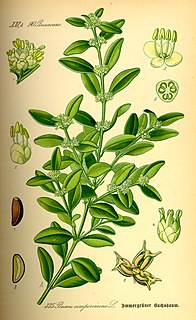
The Buxales are a small order of eudicot flowering plants, recognized by the APG IV system of 2016. The order includes the family Buxaceae; the families Didymelaceae and Haptanthaceae may also be recognized or may be included in the Buxaceae. Many members of the order are evergreen shrubs or trees, although some are herbaceous perennials. They have separate "male" (staminate) and "female" (carpellate) flowers, mostly on the same plant. Some species are of economic importance either for the wood they produce or as ornamental plants.

Nyssaceae is a family of flowering trees sometimes included in the dogwood family (Cornaceae). Nyssaceae is composed of 37 known species in the following five genera:

The Angiosperm Phylogeny Group, or APG, is an informal international group of systematic botanists who collaborate to establish a consensus on the taxonomy of flowering plants (angiosperms) that reflects new knowledge about plant relationships discovered through phylogenetic studies.

Turneraceae Kunth ex DC. is a family of flowering plants consisting of 120 species in 10 genera. The Cronquist system placed the Turneracids in the order Violales, but it is not currently recognized as a family by the Angiosperm Phylogeny Group in the APG III system of 2009, which includes the taxa in the Turneraceae in the Passifloraceae.
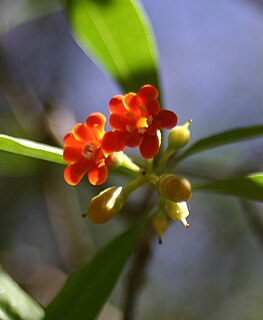
Theophrastoideae is a small subfamily of flowering plants in the family Primulaceae. It was formerly recognized as a separate family Theophrastaceae. As previously circumscribed, the family consisted of seven genera and 95 species of trees or shrubs, native to tropical regions of the Americas.

Montiniaceae is a family of flowering plants. It includes two or three genera of shrubs and small trees, native to southwest Africa and tropical East Africa as well as Madagascar. The genera Grevea and Montinia are included in most classification systems. The genus Kaliphora is included in the Montiniaceae in many newer classification systems, including the APG II, but other classification systems, including that of Armen Takhtajan, include Kaliphora in its own family, the Kaliphoraceae.
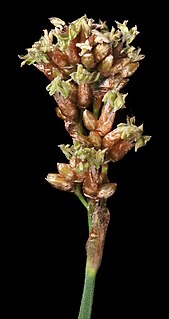
The Anarthriaceae are a family of three genera, Anarthria, Hopkinsia and Lyginia of flowering plants, now included in Restionaceae following APG IV (2016). The family is accepted in the Angiosperm Phylogeny Group's classification system, APG III system, but is not considered a separate family in many other taxonomic systems. The three genera are herbaceous but differ greatly in characteristics.

Loasaceae is a family of 15–20 genera and about 200–260 species of flowering plants in the order Cornales, native to the Americas and Africa. Members of the family include annual, biennial and perennial herbaceous plants, and a few shrubs and small trees.

The Pentaphylacaceae are a small family of plants within the order Ericales. In the APG III system of 2009, it includes the former family Ternstroemiaceae.
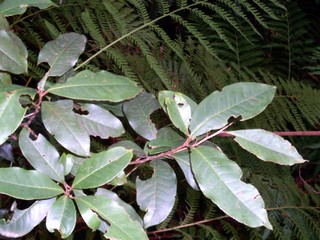
The Paracryphiaceae are a family of woody shrubs and trees native to Australia, southeast Asia, and New Caledonia. In the APG III system of 2009, the family is placed in its own order, Paracryphiales, in the campanulid clade of the asterids. In the earlier APG II system, the family was unplaced as to order and included only Paracryphia.
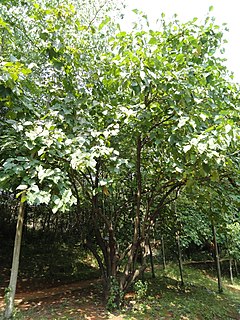
The Torricelliaceae are a family of trees native to Madagascar and southwest Asia. It contains three genera, Aralidium, Melanophylla and Torricellia. Under the APG II system, each of these genera was placed in its own family, but with the proviso that "Some of the families are monogeneric and could possibly be merged when well-supported sister-group relationships have been established." Such a relationship was established for these three genera in 2004. In the APG III system, these three genera constitute the family Torricelliaceae.
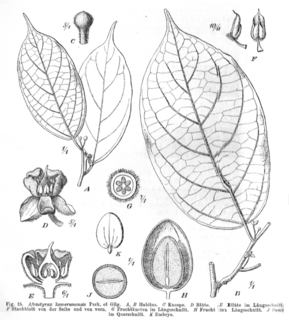
Huaceae is a family of plant in the rosids group, which has been classed in the orders Malpighiales, Malvales, and Violales or in its own order Huales. The APG II system placed it in the clade eurosids I, whereas the APG III system of 2009 and APG IV (2016) place it within the Oxalidales. The family is endemic to central Africa. It contains four species in the following two genera:

Calophyllaceae is a family of flowering plants in the order Malpighiales and is recognized by the APG III system of classification. Most of the 14 genera and 475 species included in this family were previously recognized in the tribe Calophylleae of the family Clusiaceae. The Angiosperm Phylogeny Group determined that splitting this clade of genera off into their own family was necessary.


















